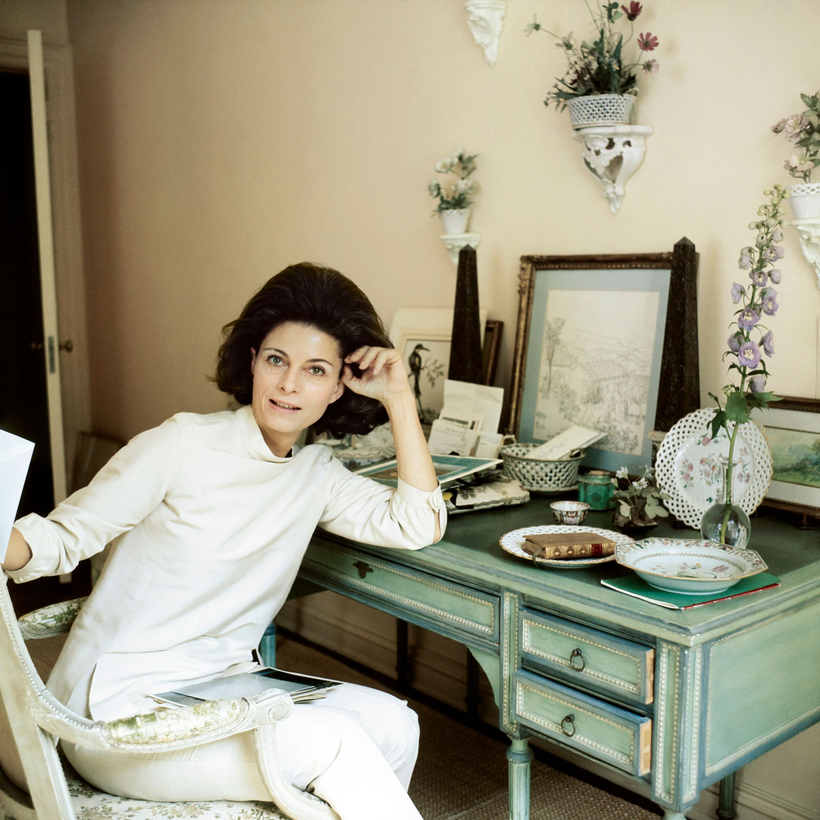I got to know Deeda Blair in the early 1980s at the Paris couture shows, a scene as much her natural habitat as high-powered Georgetown dinner parties or prestigious medical-research conferences in New York and Boston.
We shared a best friend in Sao Schlumberger, the arts patroness and wife of the French industrialist Pierre Schlumberger. The three of us would go to the twice-a-year defilés of the top couturiers—Saint Laurent, Givenchy, Valentino, Marc Bohan for Dior—they to order, and I to cover for Vanity Fair. While Sao favored the designers’ most opulent and fantastical numbers, especially for evening, Deeda gravitated to the more austere and subtle looks.
If, as the reigning empress of fashion Diana Vreeland once proclaimed, elegance is renunciation, Mrs. William McCormick Blair Jr. is living proof of the truth in that dictum. She has carried that disciplined aesthetic—it’s more than a style—of subdued luxury, of a sensuous minimalism, through every aspect of her life, from the decoration of her houses to the food she serves her guests.

One could never say of any room Deeda has created, “This is too much.” And only those who equate a lot of stuff with a lot of cash would dare to suggest her décor was too bare, too empty, lacking in grandeur. Grandeur—Deeda’s way—is never flashy, never obvious, never a declaration of social status. It’s a grandness of the imagination, the eye and the touch—of the spirit. Deeda gets the big picture, the overall scheme, and how to make it comfortable, charming, beautiful, and seductive.
It seems inevitable, then, that such a woman would not consider being elevated to the International Best-Dressed List’s Hall of Fame, as Deeda was in 1970, her greatest accomplishment, though she was no doubt grateful for the honor. Nor could she be content leading a pretty life in pretty clothes serving pretty food to pretty people in a pretty atmosphere.
In 1961, she married Bill Blair, an old-money lawyer and adviser to Adlai Stevenson, the Democratic Party candidate for president in 1952 and 1956, who had been appointed ambassador to Denmark by President Kennedy and later served as ambassador to the Philippines under President Johnson.

The newlyweds began spending their summers in France with Bill’s longtime friend Mary Lasker, who, in 1942, with her husband, founded the Lasker Foundation, a leader in the war on cancer. In 1965, Mary named Deeda vice president of the foundation’s board. (She is still vice president emeritus.)
Deeda subsequently joined the National Institutes of Health’s Breast Cancer Task Force; for 12 years, she was the only woman on its treatment committee. In 1973, she joined the board of the American Cancer Society, and in 1982 she was one of the driving catalysts behind the founding of the Harvard AIDS Initiative, ranking among its most formidable fundraisers.
Along the way she has become something of an entrepreneur, using her expertise and experience to bring together researchers and venture capitalists. Since 1987, she has been a consultant to Sandoz pharmaceuticals, and over the next three decades she would serve as a senior adviser to 18 different companies.

Deeda has now shared her extraordinary story in a book called Deeda Blair: Food, Flowers & Fantasy, edited by Deborah Needleman and published by Rizzoli. A lengthy and erudite introduction by the writer Andrew Solomon is followed by three parts: “Thoughts and Reflections,” “Fantasy Menus,” and “Recipes.”
Running throughout the 250 pages is a kind of autobiography in pictures: Deeda on the Dalmatian coast in the 1960s, by Cecil Beaton; Deeda in Denmark in 1961, by Helmut Newton; Deeda in her Washington house (decorated by Billy Baldwin) in 1972, by Horst. There’s even a quartet of Andy Warhol Polaroids.
As for the “Fantasy Menus,” they include imaginary meals in places Deeda has visited and wishes she inhabited—luncheon at Château du Jonchet, the country house of Hubert de Givenchy; dinner at Pavlovsk Palace, outside St. Petersburg—followed by 71 of Deeda’s favorite recipes, ranging from dressed-up basics such as Fried Potato Ribbons to the historic Coronation Chicken Salad, created for Queen Elizabeth II’s coronation lunch. Not surprisingly, the flower arrangements that fill the book, many created by Deeda’s friend, the artist and author Cathy Graham, are exquisite but not precious.
In 2004, after the tragic death of their son, William, the Blairs left Washington for New York, where they settled into a quiet life in a River House apartment, which Deeda, working with her close friend Daniel Romualdez, turned into a kind of serene refuge in the palest of blues and grays.

Bill died in 2015, at age 98. A year later, Deeda established the Deeda Blair Research Initiative for Disorders of the Brain at the Foundation for the National Institutes of Health, in honor of their son, who was bipolar. “There’s a gap between psychiatrists and scientists in areas like depression, anxiety, and bipolar disorders,” she tells me. And one can be sure she is doing her best to bridge it.
Last year, the Deeda Blair Research Initiative gave its first award, which includes a $100,000 research grant, to a neurosurgeon doing innovative work in those fields. “It took me three years to figure out how to do it,” she says. “I didn’t want to give an award to a star. It’s very future-oriented.”
All proceeds from her book will go to the initiative, Deeda notes, in her signature half-whisper, looking ethereal yet appropriate in a simple white cotton shirt from the Row worn over black silk pants by Adam Lippes. We are sitting in her library, its shelves lined with leather-bound first editions and the meticulous scrapbooks both she and Bill kept up for decades, chronicles of two lives well lived.
When it’s time to go, she tells me she has one request: “Please say my book is different.” That it is. And so is she, in the best possible way.

Deeda Blair: Food, Flowers & Fantasy will be published by Rizzoli on November 1
Bob Colacello is an Editor at Large for AIR MAIL

